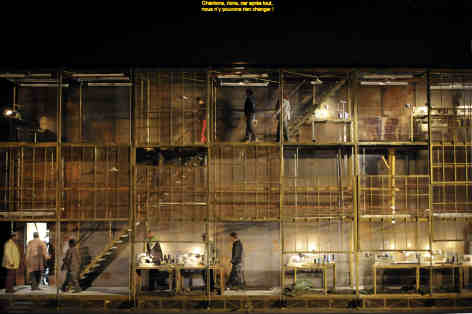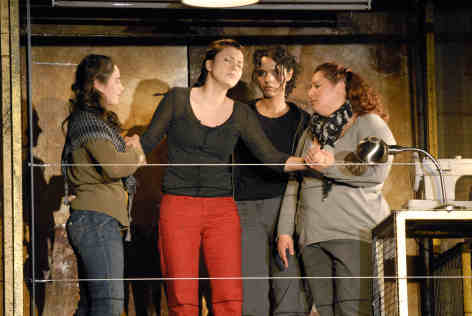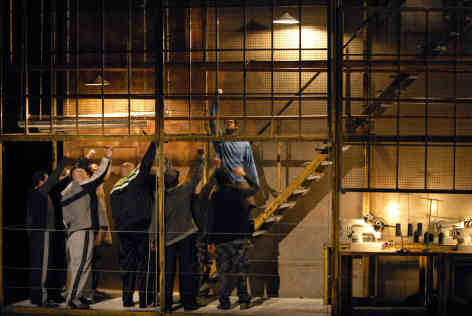Other Links
Editorial Board
- Editor - Bill Kenny
- London Editor-Melanie Eskenazi
- Founder - Len Mullenger
Google Site Search
SEEN
AND HEARD INTERNATIONAL OPERA REVIEW
Festival d’Aix en Provence (2): Mozart,
Zaide:
Soloists, Camerata Salzburg. Conductor: Louis Langrée. Théâtre de
l’Archevêché, Aix en Provence, 5.7.2008 (MB)
Zaide – Ekaterina Lekhina
Gomatz – Sean Panikkar
Allazim – Alfred Walker
Sultan Soliman – Russell Thomas
Osmin – Morris Robinson
Peter Sellars
(director)
Georges Tsypin (designs)
Gabriel Berry (costumes)
James F. Ingalls (lighting)
Ibn Zaydoun Chorus (director: Moneim Adwan)
Camerata
Salzburg
Louis Langrée (conductor)

That Zaide is a problem piece, no one would deny. The music
is far too good to lie unperformed but it is frustratingly
incomplete: something clearly must be done. It seems to me that
there are three principal paths one could take. One could make a
virtue of the incomplete nature of the ‘work’ as it stands, either
by taking up and developing the theme of fragmentation. One might
commission some new music and either provide it with a
companion-piece (as the Salzburg Festival in 2006 did) or transform
it into a new work. Or one could attempt to make it cohere as it
stands, perhaps by adding further music by Mozart. The incidental
music to Thamos, King of Egypt is a favoured candidate for
this approach, and this is what happened here. Except that it did
not. There was at root a glaring contradiction, perhaps resolvable
or perhaps not, but certainly not resolved in this particular case,
between a quasi-traditional path of Mozartian completion and
Sellars’s understanding of the work.

There is nothing wrong in principle with providing a work with a new
or modified message, although it needs to be done well – and rarely
is. Sellars, however, actually seems to believe that Zaide
itself is about what he decided to put on stage. I can say this with
some confidence by virtue of his comments in the programme. Take the
following extract from his ‘synopsis’, informing us what is going on
in that most celebrated of the work’s arias, ‘Ruhe sanft’: ‘From her
sewing machine above, Zaide (a Muslim) hears Gomatz struggle. She
sings a lullaby to ease his pain and lowers her ID card to him,
hoping her picture will bring him comfort and strength…’ Or this
commentary on Osmin’s ‘Wer hungrig bei der Tafel sitzt’: ‘This
escape is not a problem for Osmin. As a slave trader, his speciality
is outsourcing and there is an endless supply of desperate people
who will work under any conditions. From his point of view, Soliman
is behaving like one big fool. Modern management techniques offer a
huge profit from a disposable work force. The lesson is: if there is
food, eat your fill.’ For Mozart, Sellars tells us, ‘belonged to a
generation of artists, activists, intellectuals, and religious
leaders who dedicated an important part of their œuvre to the
abolition of slavery.’ This, apparently, is what the Enlightenment
was about. Except it was not – and nor is Mozart’s unfinished
Singspiel. Mozart was not the egalitarian Sellars explicitly
calls him. A little while after composing the music to Zaide,
Mozart dismissively reported to his father of Joseph II’s inclusion
of the ‘Viennese rabble’ (Pöbel)
at a
Schönbrunn ball. Such rabble, he wrote, would always remain
just that. This does not place Mozart at odds with the
Enlightenment; it places him at its heart, along with Voltaire’s
plea to his guests not to discuss the non-existence of God in front
of the servants, lest the latter should forget their place. And as
for the American plantations… The Enlightenment in general and
Mozart in particular are far more complex than a modern, liberal
American mind – or at least this one – appears able to comprehend.
Hierarchy is sometimes undermined in Mozart’s operas but never to
the extent of threatening the social order. Le nozze di Figaro
is, after all, but a ‘folle journée’, from which most of
Beaumarchais’s menacing rhetoric has been expunged.

It gets worse however, when Sellars comes to staging this
misunderstanding. (Some misunderstandings can be fruitful, but not
this.) Zaide takes place in a modern sweatshop, replete with
the ‘ID cards’, ‘modern management techniques’, and so on, which I
quoted above. Somehow the issue of Palestinian liberation becomes
embroiled in this issue and that more broadly of modern slavery; it
is all about ‘freedom’, I suppose. I hope that it should not need
saying that I abhor all forms of slavery, ancient and modern,
including the repression of Palestine, but that does not in itself
make the issue relevant to an unfinished work which is about
something quite different, nor to a production which, through its
generally ‘right-on’ contradictions, cannot make up its mind what it
was really about. We therefore had a ‘chorus’ of six modern slaves
traipse on to stage following the appropriated ‘overture’, for an
oud – I think – to strike up by way of introduction to the harmless
little song they presented. Mozart was then permitted to return,
providing different music to what I believe were the same words. We
never heard again from the Ibn Zaydoun chorus, associated with the
admirable organisation Esclavage Tolérance Zéro, nor from the
chorus’s director, Moneim Adwan. Their inclusion was offensively
tokenistic and added nothing to the botched drama on stage; they
sang well enough in an amateur fashion. The Aix audience was made to
suffer ever so slightly by the turning on of glaring strobe lighting
at the ends of musical numbers: irritating enough to be
discourteous, and obscene if the suggestion were that we could in
any sense thereby participate in the very real agonies of modern
slavery, be it in a sweatshop or the Gaza Strip. East-West tension
might fruitfully have been addressed in a work such as this, but
here it was not.
Camerata Salzburg sounded as it generally does nowadays,
post-Norrington. Sándor Végh would turn in his grave to hear the
low-vibrato, short-bowed, small-in-number (7.6.5.4.2) string
contribution, although there were moments when the section was
allowed greater musical freedom. The opening bar confronted us with
the perversely rasping sound of natural brass and with the
‘authentic’ bashing of hard sticks upon kettledrums. It was left to
the superlative woodwind section to provide Mozartian consolation.
Louis Langrée drove the score quite hard, sometimes with dramatic
flair, often with a harshness that has no place in Mozart. He was
able, however, to provide considerable dramatic continuity both
within and between numbers. Perhaps surprisingly, the Thamos
items often fared better. There were some promising young voices on
stage, although they had a tendency to present excessively
broad-brushed, unshaded interpretations – and were sometimes just
far too loud. Sean Panikkar possesses a winningly ardent tenor,
which impressed more in the first than in the second act. Thankfully
he had more to do in the first. Alfred Walker was dignified earlier
on but subsequently unfocused. What were we to make of Ekaterina
Lekhina in the title role? She delivered her second act arias rather
well, but was all over the place in ‘Ruhe sanft’: tremulous and
out-of-tune in an almost caricatured ‘operatic’ fashion. More
worryingly, why was she, a Russian soprano, included in what was
otherwise clearly a purposely-selected non-white cast? I cannot for
one moment imagine that this was the intention, but I almost had the
impression that here was a white woman, threatened and surrounded by
coloured men. Whatever the actual intention was, I am afraid that it
entirely eluded me. The impression of abject incoherence was
nevertheless intensified still further. I think that I have now said
enough.
Mark Berry
Pictures
©
Elisabeth Carecchio
Back to Top Cumulative Index Page
